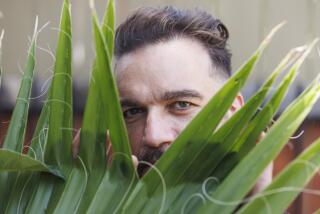Somehow, you always knew it would be...
- Share via
Somehow, you always knew it would be too good to last.
Exotic birds in lush, natural settings. An amusement park that featured sedate rides, in a place with easy freeway access, close to the city, with lots of parking close by.
And the piece de resistance that brought thousands from far and near:
Free beer.
There was a time when Busch Gardens in Van Nuys boasted a serpentine lake dotted with islands that featured beer-dispensing gazebos and lush tropical plants. Of course, the scenery also helped promote the products of Anheuser-Busch, brewer of Budweiser, Busch and other beers.
The gardens began in the 1950s when August A. Busch Jr.--whom competitors called the P. T. Barnum of the beer business--decided to open a brewery in Los Angeles. His family once owned a 30-acre winter home on South Orange Grove Boulevard in Pasadena, on a slope of the lower Arroyo Seco. For more than 30 years it was a popular tourist attraction, with a lake and waterfalls, swans and fairy-tale characters, until it closed in the late 1930s.
City leaders welcomed the West Coast branch of the St. Louis brewery to Van Nuys by providing $130,000 worth of sewer lines for the 65-acre site bounded by Roscoe Boulevard, Woodley and Haskell avenues and the railroad tracks.
Soon after the brewery opened in 1954, and every Sunday for almost two years while their new church was being raised, the congregation of the Prince of Peace Lutheran Church held its prayer services in the Budweiser taproom and cafeteria.
The Rev. Donald P. Schneider concluded his final taproom sermon: “To some people it has probably seemed strange that we have worshiped in a brewery, and yet the life of Christ is filled with many strange events.”
The brewery became so successful that by 1966 it had taken over a 20-acre cabbage patch next door and turned it into a tropical paradise and theme park. Busch Gardens soon featured a monorail, boat rides, bumper cars, lagoons, waterfalls, 2,000 birds representing 25 rare species from all over the world, live entertainment--and, once again, free beer. Busch’s policy stated that visitors who were of drinking age could have two 10-ounce glasses of beer at each of the five pavilions for an admission price of $1.75--a fee that tripled over the next 10 years.
Free beer remained available to employees until a 1982 incident in which a worker who drank beer on his breaks struck and killed a 16-year-old pedestrian as he drove out of the parking lot. After four years of negotiations between the brewery and the union, the free beer stopped flowing May 1, 1986, in the Van Nuys plant. Instead of the traditional beer breaks that had been written into union contracts, workers got two free cases to take home each month.
If beer drew some grown-ups to the gardens, the birds attracted children. Thousands of elementary schoolchildren took part over the years in Busch Gardens’ education program, which included birds on the endangered species list. The two-hour program featured a boat tour of the gardens’ flora and fauna, and behind-the-scenes looks at the bird food kitchen and holding pens for new arrivals.
In 1972, Mayor Sam Yorty opened a $6-million expansion--and was bitten on the hand by a performing otter. He required a tetanus shot.
There were older students at the brewery too--professional bartenders who sat in a classroom to learn how to put a smart head on a glass of an Anheuser-Busch beer. The brewery hosted 100 to 150 would-be bartenders in half-day sessions each month and conducted more extensive four-day courses for beer wholesalers--all to boost the sale of beer, preferably that made by Anheuser-Busch.
Every February, university canoe teams from across the country competed in a 72-hour canoe race along a three-quarter-mile course. College students didn’t have to stop paddling to get relief; spectators would hand them beers instead.
*
But other, more dazzling, entertainment began to compete for visitors’ money. In 1976, attendance plummeted to 950,000 from 1.2 million the year before. By 1977, brewery officials had converted the theme park to the Busch Bird Sanctuary. By eliminating many of the rides, insurance, safety and staff costs were cut in half.
The birds had already been boosting the brewery’s coffers. For one 3 1/2-year period, Uncle Sam paid the company $110,000 in bird-sitting fees related to a flock of fugitive parrots. Federal agents had thought the sanctuary a perfect nesting place for a seized shipment of 205 noisy and colorful Amazon parrots, smuggled in illegally through Mexico. But the government forgot about the parrot stash--until the tab arrived.
After paying the bill, government officials grumbled that it would have been cheaper just to deport the parrots, even if they all flew first class.
By 1979, the popularity of beer had led the company to move the birds and pave over the gardens for more production space. The swans and geese went to the Los Angeles Zoo. Migratory birds that had taken up residence upon discovering Busch’s bird food were taken to other wild habitats. And more than 850 of the rarest birds were jetted to Anheuser-Busch’s amusement park at Tampa, Fla.
Ultimately, a bird in the hand proved to be of lesser value than a Busch in a can.
More to Read
Inside the business of entertainment
The Wide Shot brings you news, analysis and insights on everything from streaming wars to production — and what it all means for the future.
You may occasionally receive promotional content from the Los Angeles Times.










